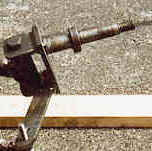Steering Arms:
The Ackerman Principle
The practice of this principle is very easy to follow and to
implement, and is on nearly every kart/ vehicle etc. The explanation isn't much
harder but I won't bore ye too much.
Firstly the steering arm is the piece of metal that is usually
welded to the front stub axle and enables the front steering wheel to be pointed
in a particular direction. If you take a look at the following picture below you
can see exactly what the steering arm is.
 In the picture to the left you can see the steering arm welded to the yoke which
allows the wheel to pivot and corner. However if you look closely at the photo
you can see that the steering arm isn't welded at 90 degrees (right angles) to
the yoke adjoined to the stub axle. There is a special angle here and it is
unique to every kart.
In the picture to the left you can see the steering arm welded to the yoke which
allows the wheel to pivot and corner. However if you look closely at the photo
you can see that the steering arm isn't welded at 90 degrees (right angles) to
the yoke adjoined to the stub axle. There is a special angle here and it is
unique to every kart.
Ackerman Angle.
I don't have an actual degrees, apart from it just been a case
of measuring it from the kart, but quite simply what I recommend/ suggest is to
lay out lengths of wood, or a full length of 25mm x 5mm flat bar out. Basically
you are following the set-up shown in the photo below:

The Ackerman Angle is what ever angle is formed by the line
running from the main kingpin on each side of the front of the kart to the very
centre of the rear axle. As in the photo above the angle was obtained and the
steering arms were welded to the yoke/ front stub axle maintaining this angle.
The steering arms are firstly however cut to the appropriate
length, you may see from some of my photos throughout this site that I have
drilled two holes at the ends of both steering arms. This is in case a
particular driver prefers a more abrupt turning of the kart with little turning
of the steering wheel and visa versa. I have to say however I have not changed
it and I have left it at a standard of around 150mm, that is the distance from
where the arm is welded to the kart and the hole for the connecting bolt.
A quick word,
Incorporating this steering angle into the kart will improve
it's cornering, without this angle the kart won't take corners smoothly and will
increase tire wear. Using this angle allows the two front wheel to turn by
different amounts so that the tracks of the two front wheels are not the same.
If you are confused, don't worry it's not that essential to know about it, just
only that it works.
Return to Racing Kart Section
 In the picture to the left you can see the steering arm welded to the yoke which
allows the wheel to pivot and corner. However if you look closely at the photo
you can see that the steering arm isn't welded at 90 degrees (right angles) to
the yoke adjoined to the stub axle. There is a special angle here and it is
unique to every kart.
In the picture to the left you can see the steering arm welded to the yoke which
allows the wheel to pivot and corner. However if you look closely at the photo
you can see that the steering arm isn't welded at 90 degrees (right angles) to
the yoke adjoined to the stub axle. There is a special angle here and it is
unique to every kart.